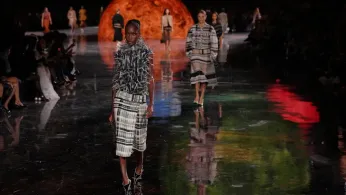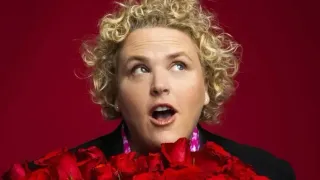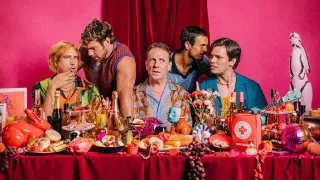
7 hours ago
Showmanship Returns at Chanel As Designer Blazy Debuts Under a Sky of Planets
Thomas Adamson READ TIME: 3 MIN.
Showmanship returned to Chanel on Monday.
At Paris Fashion Week, its new designer Matthieu Blazy opened the season’s most anticipated debut beneath colossal celestial bodies — Saturn with its rings, a full solar system suspended above a jet-black and a mirror-bright runway — staking a claim for theater from the first second.
Reflections mirrored the cosmos beneath the runway, while a front row constellation — Nicole Kidman, Marion Cotillard, Tilda Swinton, joined by Lauren Sanchez and Jeff Bezos — gazed upward.
By night’s end, the room rose in a standing ovation. As Vogue's doyenne Anna Wintour has said, “fashion needs its showmen.”
Chanel had one again.
Founded in 1910, Chanel reshaped women’s wardrobes by replacing corseted silhouettes with ease — jersey, trousers — and later codified a global idea of Parisian chic through the little black dress, pearls and the tweed suit. Under Karl Lagerfeld in the 1980s, it became the model for how a heritage house can be both historic and relentlessly modern, its runway spectacles influencing the industry far beyond Paris. That legacy made Blazy’s debut more than a change of designer, but a test of how a century-old, multi-billion dollar institution continues to speak to the world.
The show capped a season dense with debuts: Pierpaolo Piccioli at Balenciaga, Louise Trotter at Bottega Veneta, Jack McCollough and Lazaro Hernandez at Loewe and Dario Vitale at Versace.
Yet Chanel’s moment felt singular for stakes and scale. By dialing down glitter, dialing up line, restoring theater and keeping the codes legible, Blazy positioned Chanel not as a museum of symbols but as a platform for them.
The opener functioned as a manifesto: an androgynous, slouchy pantsuit featuring low-slung trousers and an asymmetric jacket with structured shoulders. The looks split from the playbook of subdued designer Virginie Viard who parted ways with Chanel last year. They also shifted from late-period Karl Lagerfeld — one step closer to Gabrielle “Coco” Chanel.
The styles were not a reinvention of tweed, but rather menswear rethought through the founder’s origin story, when Coco wore the clothes of her lover the “Boy” Capel.
A hand anchored in a pocket made the point explicit: the freedom Chanel once placed in women’s hands — giving them trousers and pockets on them — restated. The spring 2026 collection, months in the making, read as an imagined conversation between Blazy and Chanel herself: thoughtfulness braided with showmanship.
Ribbons — rumored to be a sticking point between designer and atelier — were largely gone. Sparkle was sparse, a calculated risk in markets that prize high shine.
In their place came silhouette-first solutions and masses of feathers, with the camellia held as steady leitmotif. However far the line moved, the codes stayed legible — each look unmistakably Chanel. Tweed arrived interconnected rather than narrowly Parisienne — multicultural in palette and weave, intercontinental if not interplanetary.
Then came the fun wigs — what one critic termed the “funny little hats” — feathered, sly and intentionally light. They channeled Lagerfeld’s provocation about how he revitalized the once-dusty heritage house when he joined the helm in 1983.
“Chanel is an institution, and you have to treat an institution like a (prostitute) — and then you get something out of her," he said.
While Viard’s Chanel was often faulted for sobriety and restraint; Blazy, like Lagerfeld, deals in irony. At Bottega Veneta he staged frogs on heels, bunny-lapel coats and trompe-l’œil leather jeans. Here, plumage, proportion and wigs delivered the wink without tipping into theatrical costume.
Accessories set a new tempo: big hats, metallic bags, tiers of pearls, chunky gold chains and statement earrings — bold on paper, disciplined on the body. Handbags — the other reason Blazy was chosen — spanned crisp chain-strap updates and playful clutches, including a notable ovoid shaped like an egg.
The finale carried the argument in motion: a silky short-sleeve shirt paired with a multicolored feathered skirt with a long train. Color moved across the plumage and the black floor threw back its reflection.
“It was such a surprise. ... It’s exciting to be here for a new era," filmmaker Sofia Coppola told The Associated Press. “There are things you recognize from the house codes, and a fresh new look at it.”






